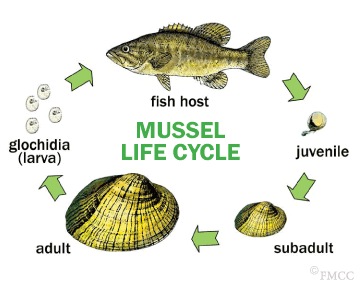Life Cycle of the JRSM
The life cycle of a mussel is both unique and complex beginning with the release of the male mussel’s sperm into open water. After flowing through the water, the sperm is drawn into the females through their siphons. The eggs are located in the female's gills and the sperm is brought in through the siphons to fertilize the eggs. Inside the female mussels, the eggs develop into microscopic larvae, also known as glochidia with only 1 out of 1,000,000 glochidia reaching the juvenile stage. In order to complete the reproduction process, the female mussel must infect a host fish with the glochidia. After, the glochidia is released from the female, they attach to the fins, gills, and scales of the host fish (see “fishing page”). On the host fish, the glochidia begins developing a foot, gills, and many internal structures such as the liver, and siphons. Upon being further-developed, the juvenile mussel will drop off the host and start their life. For most mussels the juvenile stage can last from 2 to 12 years. The last step in the mussel’s life cycle is the sub-adult stage where they will gain the capability to reproduce then restarting the cycle. One study claims that the lifespan of a mussels can be as long as 15 years. The spiny mussel habitat has to provide for all transitions the organism goes through, providing all the resources it might need in order to sustain this intricate process. Therefore it is crucial we find the right river with perfect conditions for this endangered animal.




